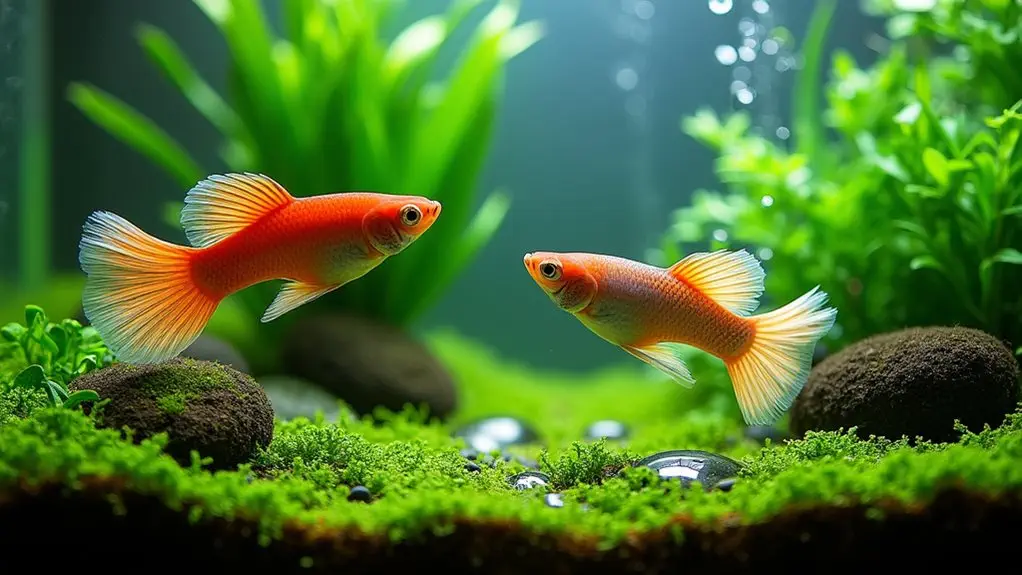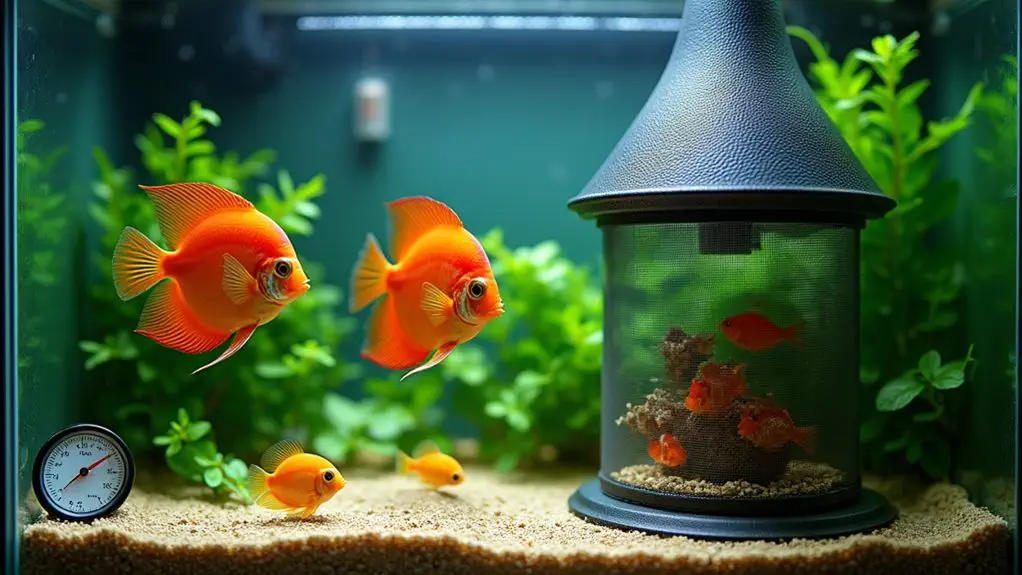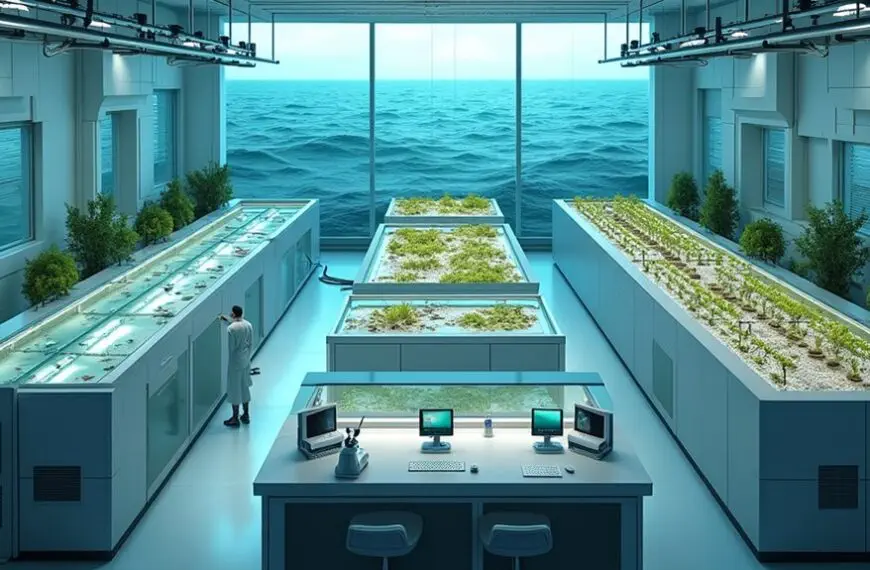Successful fish breeding starts with creating ideal water conditions that mimic natural spawning environments. You'll need to select healthy breeding stock with vibrant colors and active behavior, then condition them with high-protein foods. Design species-specific habitats with appropriate spawning surfaces, and maintain strict water quality parameters. Once your fry hatch, feed them 3-4 times daily and perform gentle water changes. These careful preparations will transform your aquarium into a thriving nursery for the next generation.
Contents
- 1 Creating Optimal Water Conditions for Spawning
- 2 Selecting and Conditioning Healthy Breeding Stock
- 3 Designing Species-Specific Breeding Environments
- 4 Nutritional Requirements for Breeding Success
- 5 Fry Care and Management Techniques
- 6 Frequently Asked Questions
- 6.1 How Long Should I Separate Males and Females Before Breeding?
- 6.2 Can Different Fish Species Be Bred in the Same Tank?
- 6.3 How Do I Identify Genetic Disorders in Potential Breeding Stock?
- 6.4 What's the Best Method for Documenting Breeding Lineage?
- 6.5 How Do Hormones Affect Breeding Success in Difficult Species?
- 7 Final Thoughts
Creating Optimal Water Conditions for Spawning

When breeding fish successfully, water quality stands as the foundation for everything that follows.
Quality water is the cornerstone of all successful fish breeding endeavors.
You'll need to monitor and adjust water temperature carefully, as most species have specific ranges that trigger their reproductive behavior. Too cold or too warm, and your fish simply won't be in the mood!
pH levels are equally important but often overlooked by beginners. Your aquatic friends need their water chemistry just right – think of it as setting the perfect romantic atmosphere!
Most freshwater breeding species prefer slightly acidic to neutral pH (6.5-7.2), while marine breeders typically need more alkaline conditions.
Don't forget to check these parameters daily during breeding season. It's amazing how a small adjustment can transform reluctant fish into enthusiastic parents!
Additionally, maintaining stable ammonia levels is crucial during this period to ensure the health and safety of your breeding fish.
You're not just maintaining an aquarium; you're creating a nursery for the next generation.
Selecting and Conditioning Healthy Breeding Stock
The foundation of successful fish breeding lies in choosing the right parent stock, much like how champion racehorses produce winning offspring.
You'll want to select fish that exhibit vibrant colors, proper fin development, and active swimming patterns. Through careful behavioral observation, you can identify the most robust specimens with ideal mating tendencies.
Don't rush this process! Take time to quarantine new arrivals for at least two weeks, ensuring they're disease-free before introduction to your breeding tanks.
Maintaining genetic diversity is vital—avoid breeding closely related fish, which can lead to weakened offspring with compromised immune systems.
Condition your breeders with high-quality, varied diets rich in live foods like bloodworms and brine shrimp. This nutritional boost triggers spawning behavior and improves egg and sperm quality, dramatically increasing your chances of breeding success. Additionally, ensure that your tank conditions, such as optimal water temperature, are suitable for the species to encourage healthy breeding practices.
Designing Species-Specific Breeding Environments

Creating an ideal breeding environment tailored to your specific fish species dramatically increases your chances of spawning success. Research your fish's natural habitat and breeding behavior before setting up their spawning tank.
The right breeding setup can make all the difference between success and frustration when spawning aquarium fish.
For cichlids, include flat rocks or flowerpots where they'll deposit eggs, while livebearers need dense vegetation for fry to hide.
Temperature plays an essential role in triggering spawning—you'll need to adjust it slightly (usually warmer) to simulate seasonal changes that prompt breeding behavior.
Don't forget water parameters! Some species require softer water for successful reproduction, while others need higher pH levels. Cycling your tank prior to breeding is also crucial to establish beneficial nitrifying bacteria which helps create a stable environment.
Habitat simulation extends to lighting too. Many fish respond to photoperiod changes, so you might need to gradually increase daylight hours to mimic their breeding season.
Nutritional Requirements for Breeding Success
Proper nutrition serves as the foundation for successful fish breeding, often making the difference between failed attempts and healthy fry. When preparing your fish for breeding, you'll need to increase both the quality and quantity of their food. High-protein options like bloodworms, brine shrimp, and daphnia help develop eggs and sperm.
Consistent feeding schedules are essential—aim for 2-3 small meals daily rather than one large feeding. Your breeding fish will thank you for this routine!
Don't forget about dietary supplements rich in vitamins C and E, which boost fertility and strengthen immunity. For example, spirulina powder sprinkled on food can enhance vibrant coloration (a sign of good health).
Fry Care and Management Techniques

Once your fish have successfully spawned, caring for the tiny fry becomes your most critical challenge.
These delicate newcomers require special attention to thrive in their first weeks of life. You'll need to establish a consistent fry feeding schedule, typically 3-4 times daily with specialized food like infusoria or commercial fry powder that matches their tiny mouths.
Tank maintenance takes on new importance with fry present.
You'll want to perform gentle water changes (about 10-15% daily) using an airline tubing covered with fine mesh to prevent accidentally siphoning the babies.
Keep the water exceptionally clean but avoid dramatic parameter shifts that could stress their developing systems. Additionally, maintaining optimal water quality is crucial for the health and growth of fry, as it supports their delicate immune systems.
Frequently Asked Questions
How Long Should I Separate Males and Females Before Breeding?
You'll want to separate males and females for 1-2 weeks before breeding. It's essential for conditioning. Using proper separation methods like dividers or separate tanks can considerably improve your breeding timelines and success rates.
Can Different Fish Species Be Bred in the Same Tank?
With 90% of hybrid attempts failing, you shouldn't breed different fish species in the same tank. You'll face serious species compatibility issues and can't maintain ideal tank conditions for each species simultaneously.
How Do I Identify Genetic Disorders in Potential Breeding Stock?
You'll spot genetic disorders by watching for abnormal colors, deformities, and unusual behavior. Consider genetic testing for valuable breeding stock and observe fish for disease symptoms like stunted growth or swimming problems.
What's the Best Method for Documenting Breeding Lineage?
Ever wondered how to track your fish family trees? You'll find success using spreadsheets or specialized breeding software for lineage tracking. Take clear photos and maintain detailed documentation methods recording dates, parents, and notable traits for each generation.
How Do Hormones Affect Breeding Success in Difficult Species?
You'll find hormonal influence critical for overcoming breeding challenges in stubborn species. Synthetic hormones can trigger spawning behavior when natural cues fail. They're especially effective when paired with proper environmental conditioning and nutrition.
Final Thoughts
You're now armed with the essentials, ready to transform your aquarium from pet shop to nursery! While breeding fish requires science and precision, it's also an art filled with wonder. The challenge of perfect water chemistry contrasts beautifully with the simple joy of watching new life emerge. By combining these practices with patience and care, you'll soon witness the miracle of tiny fry darting through your carefully crafted underwater world.












